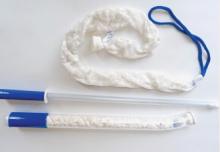Updated option for breast biopsy
Hologic announces updates to its Brevera® Breast Biopsy System with CorLumina® Imaging Technology. The Brevera system is designed for use with the manufacturer’s Affirm® Prone biopsy guidance system.
Available since 2017, the Brevera system is designed to enhance the workflow for the breast biopsy procedure and overall patient experience by allowing for real-time imaging of sample acquisition. This feature avoids the need for the clinician to leave the patient exam room to verify tissue samples, saving time during the patient visit and allowing for more clinician-patient interaction. Brevera also combines tissue acquisition and real-time imaging verification with postbiopsy handling, with new functionality and simplified storage, including stowage of disposable needles, and improved waste management. The combination of the system improvements help to maintain the sample integrity, says Hologic, allowing for radiologists and technicians to handle the sample and then for the transfer to pathology. According to the manufacturer, the improved features offer facilities the potential to save an average of 13 minutes per procedure.For more information, visit https://www.hologic.com.
“Mini-sponge” device shows potential to treat PPH
Although its research is in the pilot phase, Obstetrx, Inc. announces its XSTAT device has shown success in stopping postpartum hemorrhage (PPH) quickly. The device is a novel uterine tamponade “mini-sponge.” Contained in an applicator, XSTAT is comprised of compressed mini-sponges that are inserted into the postpartum uterus. Contained in a porous, distensible pouch, the sponges expand quickly, applying hemostatic pressure within the uterus. After a period of observation, the pouch is removed with gentle traction on the removal strand.
During a pilot study, reports Obstetrx, 9 patients, treated at the University Teaching Hospital in Lusaka, Zambia, did not respond to conventional PPH management options after vaginal birth but did respond, with bleeding resolved in 60 seconds and no adverse events, to the XSTAT device. The device was left in place for a mean time of 1 hour, and none of the patients required further surgical procedures or blood transfusions. The initial placement time of XSTAT (mean time to placement, 62 seconds) was faster than times reported for balloon uterine tamponade devices. The pilot study results were published in Obstetrics & Gynecology.
XSTAT is US Food and Drug Administration–approved to treat high-flow arterial bleeding in prehospital trauma settings, and Obstetrx is planning to submit for 510k clearance in 2022, after the conclusion of a follow-up PPH trial in 2021.
For more information, visit: https://www.obstetrx.com/.
Continue to: AI and ovulation prediction...



